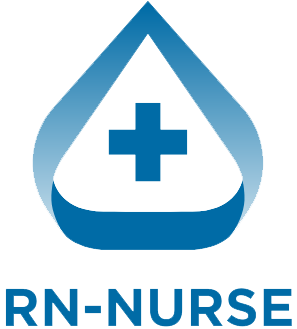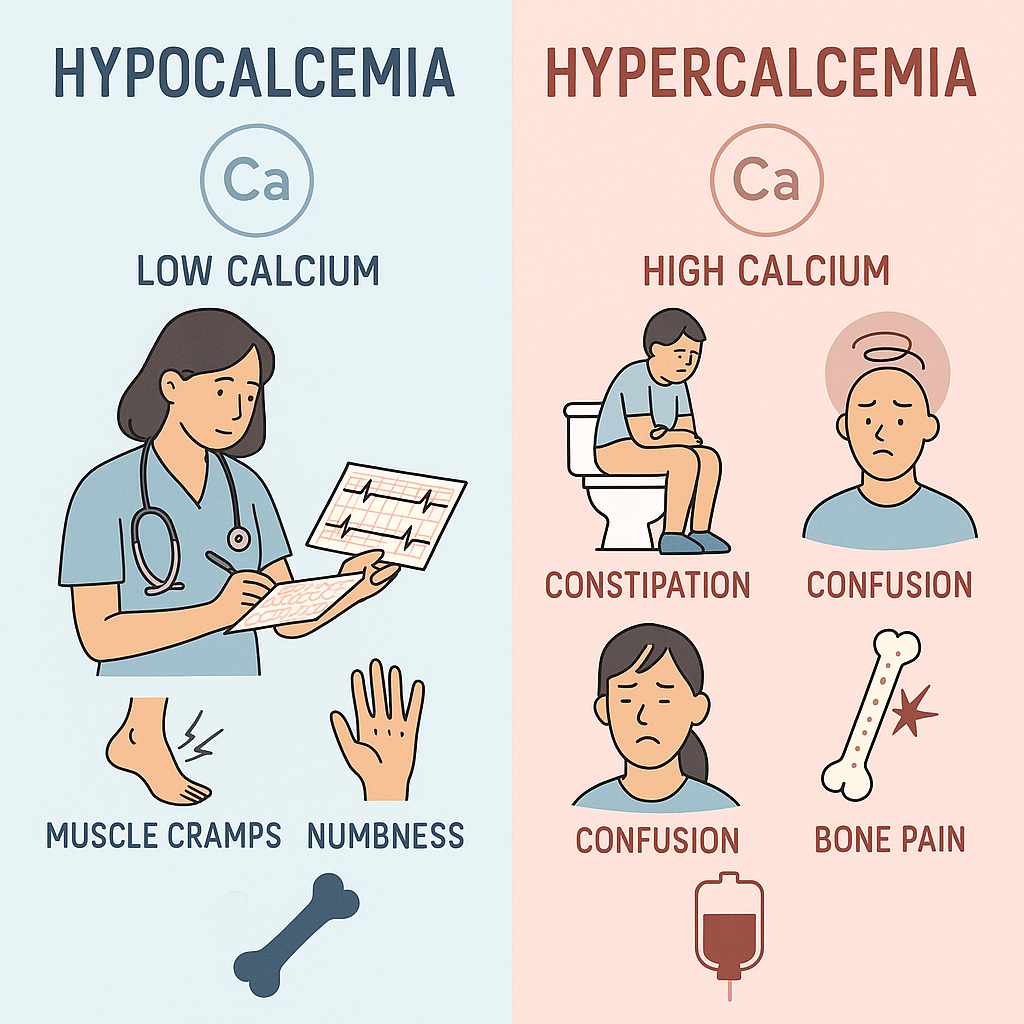Introduction: Why Calcium Matters
Calcium is one of the most important minerals in the human body. It supports bone strength, muscle contraction, nerve signals, and blood clotting. Too much or too little calcium in the blood can lead to serious health issues. That’s why it’s essential for nurses to know how to spot and treat imbalances quickly.
This guide breaks down two common calcium problems: hypocalcemia (low calcium) and hypercalcemia (high calcium). We’ll cover signs, causes, EKG changes, and what nurses should do.
What Is Calcium Imbalance?
A calcium imbalance happens when the level of calcium in the blood is either too low or too high.
- Normal calcium level: 8.5 to 10.5 mg/dL
- Hypocalcemia: Less than 8.5 mg/dL
- Hypercalcemia: More than 10.5 mg/dL
Even small changes outside this range can affect how a patient feels or how their heart works.
Hypocalcemia: Low Calcium Levels
Signs and Symptoms
Patients with hypocalcemia may show:
- Muscle cramps or spasms
- Tingling around the mouth or in fingers/toes
- Seizures
- Chvostek’s sign (twitching when tapping cheek)
- Trousseau’s sign (hand spasm with blood pressure cuff)
- Weak heartbeat
- Confusion
Common Causes
- Vitamin D deficiency
- Kidney failure
- Hypoparathyroidism
- Low magnesium
- Blood transfusions (due to citrate)
- Pancreatitis
- Certain medications like loop diuretics
EKG Changes
- Prolonged QT interval
- Risk of torsades de pointes (a dangerous heart rhythm)
Nursing Interventions
- Monitor calcium levels and EKG
- Administer calcium supplements (oral or IV)
- Give vitamin D if needed
- Seizure precautions
- Educate patients on calcium-rich foods (dairy, leafy greens, almonds)
Hypercalcemia: High Calcium Levels
Signs and Symptoms
- Fatigue and weakness
- Nausea or vomiting
- Constipation
- Increased thirst and urination
- Confusion
- Bone pain
- Kidney stones
Common Causes
- Hyperparathyroidism
- Cancer (especially bone metastases)
- Excessive calcium or vitamin D intake
- Prolonged immobilization
- Thiazide diuretics
EKG Changes
- Shortened QT interval
- Risk of arrhythmias (like ventricular tachycardia)
Nursing Interventions
- Monitor calcium levels and heart rhythm
- Encourage fluids (oral or IV) to flush out calcium
- Administer loop diuretics (e.g., furosemide)
- Avoid calcium-rich foods
- Educate patients on causes and prevention
- Administer bisphosphonates if ordered (for cancer-related hypercalcemia)
The Nurse’s Role in Managing Calcium Levels
As a nurse, your role in identifying and treating calcium imbalance is vital. You are often the first to notice changes in a patient’s condition. Regular monitoring, fast reporting, and timely intervention can save lives.
Here are essential tips:
- Check labs regularly, especially in high-risk patients.
- Know baseline EKGs and watch for changes.
- Educate patients and families about symptoms.
- Keep emergency supplies ready (e.g., calcium gluconate).
- Collaborate with doctors and nutritionists.
Case Example: Recognizing Hypocalcemia Fast
Imagine a patient recovering from thyroid surgery. They start showing muscle twitching and report tingling in their lips. You notice a positive Chvostek’s sign.
You check their labs — calcium is 7.8 mg/dL.
As the nurse, you:
- Notify the doctor
- Start calcium gluconate IV
- Monitor EKG
- Educate the patient on signs to report
Quick action can prevent seizures or cardiac issues.
Dietary Tips for Calcium Balance
Teach patients how diet helps maintain proper calcium levels.
Foods Rich in Calcium:
- Yogurt
- Cheese
- Sardines
- Tofu
- Fortified cereals
Foods to Avoid in Hypercalcemia:
- Excessive dairy
- Calcium-fortified juice or supplements
Also, educate about vitamin D — it helps absorb calcium effectively.
Pharmacology Pearls
Some medications affect calcium:
- Loop diuretics (e.g., furosemide) lower calcium
- Thiazide diuretics increase calcium
- Bisphosphonates treat high calcium in cancer
- Calcitonin lowers calcium levels
- Calcium gluconate raises calcium fast
Know the side effects and how to monitor patients receiving these drugs.
When to Call the Doctor
Call the provider if you see:
- Sudden muscle spasms or seizures
- Confusion or behavior changes
- Heart rhythm changes
- A rapid drop or rise in calcium levels
Conclusion
Calcium imbalances can cause serious problems, but they’re manageable when caught early. Knowing how to recognize the signs of hypocalcemia and hypercalcemia, reading EKG changes, and taking fast nursing action can make a huge difference.

